A proposal to extend the timeline for review of the City of Kenai’s draft land management plan was rejected by members of the Kenai City Council’s at their Dec. 1 meeting. Those who supported extending the timeline for review said it would allow for more public input and clarifications, while those opposed said sufficient time for review has been given.
The land management plan, which has been in the works since the council gave the project the go-ahead in 2018, is intended to create a “city-wide approach” to managing the approximately 5,540 acres of land owned by the city.
City administration presented the plan in October to both council members and commissioners. Each planning commission was then tasked to review and compile recommendations on the plan for the city council at their own pace. Under that timeline, final council approval of the plan was slated for the council’s first meeting in January.
Alternatively, council members Teea Winger and Jim Glendening proposed dividing the 220-page land management plan into four chunks that each of the city’s commissions would review one at a time across four meetings before making their recommendations.
“Based on the scope and breadth of the document and discussions at commission meetings, it has become evident that additional time is needed to allow for effective review and comment,” the memo says, adding that breaking the plan into “more manageable sections” would help facilitate discussion.
The draft land management plan is 220 pages, 46 of which are maps showing parcels of land in the city. For comparison, the council’s Wednesday night meeting packet, including laydown material, totaled 239 pages, with the earliest iteration distributed publicly on Nov. 24.
Winger and Glendening said a thesaurus of terms explaining, among other things, planning and zoning terminology as well as a guide to the city’s zoning codes, could make the document more accessible. Adopting the expanded schedule would also allow more time to solicit public and commission input, they said.
Kenai City Manager Paul Ostrander wrote in a Nov. 17 email to Winger and Glendening that the council members’ proposed structure would require about 40 hours of staff time and said the city is currently “short-staffed with employees covering multiple desks.” He went on to propose an alternative structure that he said would still allow council members and commissioners to get the information.
He proposed putting together a memo explaining city zoning, an overview of relevant sections of city code and providing background for the terms “retain” and “dispose” as used in city code and in the plan. Those materials, he wrote, would take about 10 hours of staff time to prepare and provide resources that are “easy to digest and reference” at council members’ and commissioners’ convenience, while also allowing them to follow up with questions.
“I am confident that we can accomplish your objective of providing good information to Council Members and commissioners through this alternative approach,” Ostrander wrote.
Winger said during the council’s Wednesday night meeting that she thought to bring forth the legislation after receiving “minimal feedback” from commissioners after they were presented with the plan.
“We thought that by pulling back to maybe break it down, we’ll have better buy-in on feedback from our commissions as well as get better buy-in from the public,” Winger said. “This is a key tool for our city.”
Alex Douthit, a planning and zoning commissioner, suggested that commissioners and the public aren’t submitting feedback because they don’t have any comments. He went on to say that the document, while important, is an inventory and resource for the city and that, ultimately, all land decisions are made by council members.
“Maybe they don’t have any suggestions,” Douthit said, noting that commissioners had had the documents for months. “Quite frankly, when I bring this up to the public, a lot of them — I hate to say it — are, like, ‘I don’t care.’ … We can’t force people to show up if they don’t want to.”
Regarding concerns that some commissioners may not be able to fully understand the draft plan as presented, council member Glenese Pettey said she trusts they can, adding that members of the Harbor Commission were ready to move forward with recommendations following a presentation at their most recent meeting.
“They’re on the commission,” Pettey said. “They know what words mean and if there’s a misunderstanding they can come forth and ask.”
Pettey went on to say that harbor commissioners moved to postpone submitting their recommendations until January after Glendening spoke at that meeting.
“I give (commissioners) the benefit of having the capability of comprehending what’s going on,” Pettey said. “ … I don’t think we need to spoon feed them. I give them great consideration that they can comprehend what’s in this.”
The council ultimately moved to continue with the timeline established by city administration in October, with Ostrander planning to make the resources described to Winger and Glendening available “as soon as possible.” Commissions will be allowed to read the plan and make recommendations at their own pace.
Wednesday’s full meeting of the Kenai City Council can be viewed on the city’s YouTube channel.
Reach reporter Ashlyn O’Hara at ashlyn.ohara@peninsulaclarion.com.

